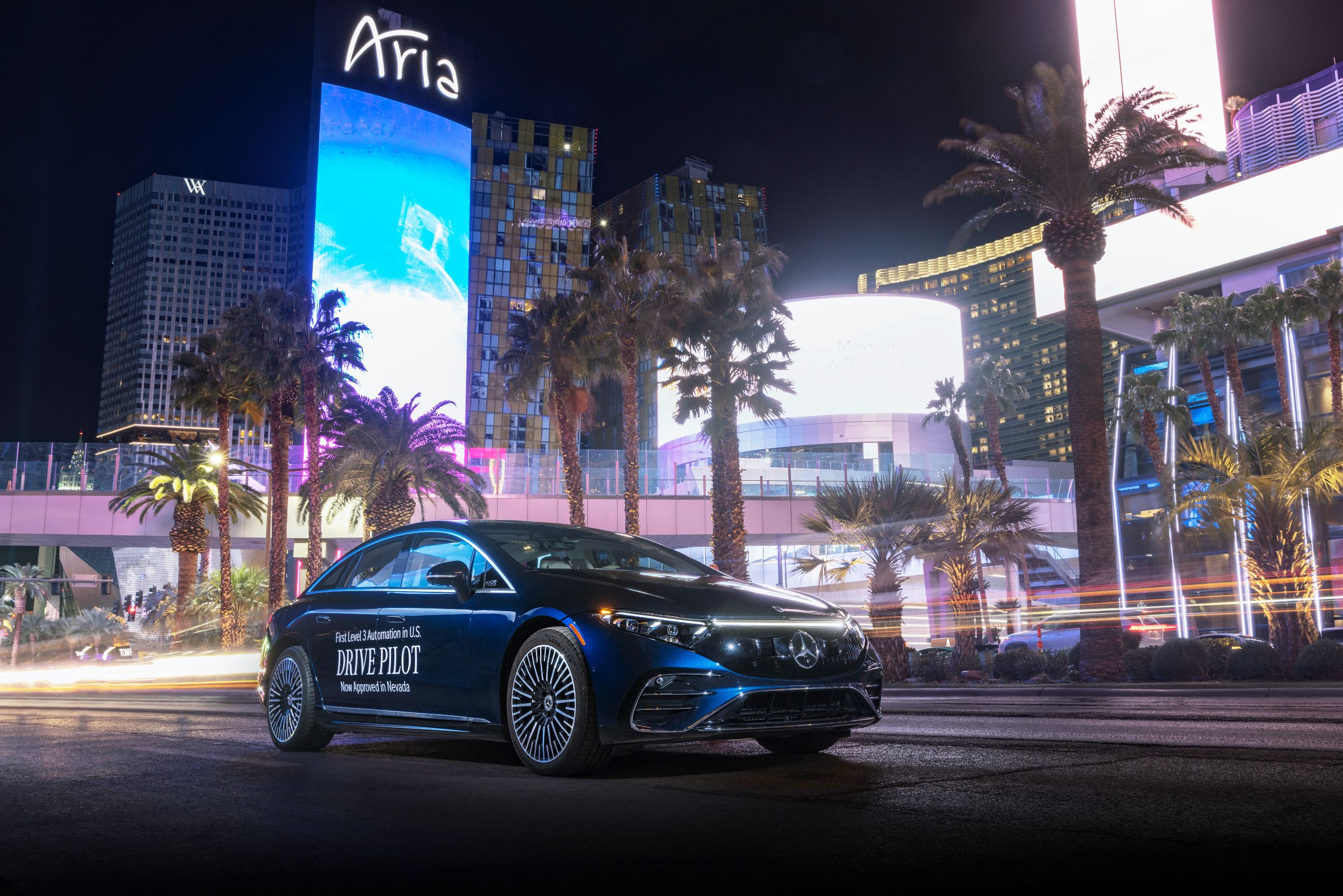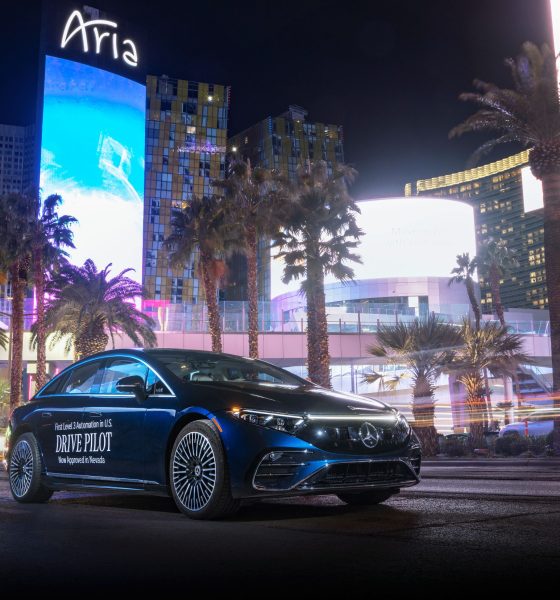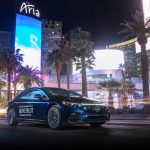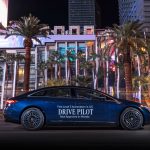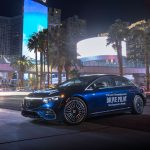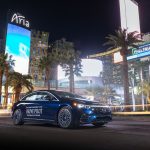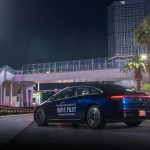Mercedes-Benz has officially received certification to operate its SAE Level 3 autonomous driving system, DRIVE PILOT, in Nevada, making it the first brand to do so in the United States.
Mercedes first launched its DRIVE PILOT system at the end of 2021. Then they began shipping vehicles with the capability to customers in Germany in mid-2022, becoming the first automaker in the country to pass through the government’s stringent autonomous driving certification process.
Now, the brand has become the first to receive certification in the United States.
The DRIVE PILOT system is officially certified to operate on “suitable freeway sections” in Nevada in high-traffic density situations. It can operate at speeds up to 40 MPH. The company first revealed its paperwork had been filed with Nevada and California earlier this year, with California expected to grant certification later this year. Currently, DRIVE PILOT is available on the Mercedes EQS Sedan and Mercedes S-Class sedans, with vehicles being delivered with the system beginning in the second half of this year.
- Credit: Mercedes-Benz
- Credit: Mercedes-Benz
- Credit: Mercedes-Benz
Mercedes-Benz was granted this approval as DRIVE PILOT meets the requirements of Nevada Chapter 482A for Autonomous Vehicles. As Mercedes states, some functions and applications will be available that would otherwise be blocked while driving. These activities are legally permissible depending on laws that apply where DRIVE PILOT is being used.
Best outlined by Mercedes Board Member Markus Schäfer, this is just the beginning of a larger rollout of the software:
“DRIVE PILOT demonstrates once more that our pioneering spirit is part of our DNA. Certification in Nevada marks the start of its international rollout and, with it, the dawning of a new era.”
To achieve this certification, among other regulations, Mercedes showed that its set of redundant driving systems could keep drivers safe while controlling the vehicle. A combination of steering, braking actuators, and onboard electrical system redundancy measures keep the vehicle maneuverable, even if a system fails.
- Credit: Mercedes-Benz
- Credit: Mercedes-Benz
Additionally, the vehicles will rely on a combination of LiDAR, radar, and cameras that allow the car to monitor where it is relative to other vehicles constantly down to the centimeter. Mercedes combines these systems with high-precision GPS mapping, ensuring the most consistent experience possible.
DRIVE PILOT will also take matters into its own hands if drivers fail to take back control, even after “increasingly urgent” audible and visual alerts. Mercedes said that it would brake the vehicle to a standstill in a controlled manner, then will activate hazard lights. Doors will be unlocked, and Mercedes’ emergency call system will contact first responders. This is an increasingly needed feature in case of a major medical emergency.
While the Mercedes technology has often been drawn as a parallel to Tesla’s Full Self-Driving offering, through this most recent certification, Mercedes now differentiates itself in two ways. Foremost, in a crash with another vehicle, while DRIVE PILOT is engaged, Mercedes accepts legal liability for the accident. Furthermore, this certification has shown relevant authorities that it can operate safely, a process that Tesla will likely need to follow through in the near future.
Mercedes’ announcement also follows a series of other major milestones for the company. The German luxury automaker recently revealed that it would be opening its own series of EV chargers, starting in North America and working globally. Mercedes has also recently highlighted (in granular detail) its incredible production shift to EVs occurring worldwide and utilizing each of its current manufacturing plants.
While there is no doubt many still see Mercedes as a non-threat to Tesla’s Full Self-Driving suite, today’s announcement proves otherwise. Hopefully, through this continued competition, autonomy can improve overall and become available to most people as a safe alternative to regular vehicle operation.
Alongside DRIVE PILOT, Mercedes also announced that its Level 2 driver assistance system would make its North American debut later this year, which features ADAS features like autonomous lane merging, speed controls, and perhaps most importantly, emergency braking.
What do you think of the article? Do you have any comments, questions, or concerns? Shoot me an email at william@teslarati.com. You can also reach me on Twitter @WilliamWritin. If you have news tips, email us at tips@teslarati.com!

News
Tesla FSD fleet is nearing 7 billion total miles, including 2.5 billion city miles
As can be seen on Tesla’s official FSD webpage, vehicles equipped with the system have now navigated over 6.99 billion miles.

Tesla’s Full Self-Driving (Supervised) fleet is closing in on almost 7 billion total miles driven, as per data posted by the company on its official FSD webpage.
These figures hint at the massive scale of data fueling Tesla’s rapid FSD improvements, which have been quite notable as of late.
FSD mileage milestones
As can be seen on Tesla’s official FSD webpage, vehicles equipped with the system have now navigated over 6.99 billion miles. Tesla owner and avid FSD tester Whole Mars Catalog also shared a screenshot indicating that from the nearly 7 billion miles traveled by the FSD fleet, more than 2.5 billion miles were driven inside cities.
City miles are particularly valuable for complex urban scenarios like unprotected turns, pedestrian interactions, and traffic lights. This is also the difference-maker for FSD, as only complex solutions, such as Waymo’s self-driving taxis, operate similarly on inner-city streets. And even then, incidents such as the San Francisco blackouts have proven challenging for sensor-rich vehicles like Waymos.
Tesla’s data edge
Tesla has a number of advantages in the autonomous vehicle sector, one of which is the size of its fleet and the number of vehicles training FSD on real-world roads. Tesla’s nearly 7 billion FSD miles then allow the company to roll out updates that make its vehicles behave like they are being driven by experienced drivers, even if they are operating on their own.
So notable are Tesla’s improvements to FSD that NVIDIA Director of Robotics Jim Fan, after experiencing FSD v14, noted that the system is the first AI that passes what he described as a “Physical Turing Test.”
“Despite knowing exactly how robot learning works, I still find it magical watching the steering wheel turn by itself. First it feels surreal, next it becomes routine. Then, like the smartphone, taking it away actively hurts. This is how humanity gets rewired and glued to god-like technologies,” Fan wrote in a post on X.
News
Tesla starts showing how FSD will change lives in Europe
Local officials tested the system on narrow country roads and were impressed by FSD’s smooth, human-like driving, with some calling the service a game-changer for everyday life in areas that are far from urban centers.

Tesla has launched Europe’s first public shuttle service using Full Self-Driving (Supervised) in the rural Eifelkreis Bitburg-Prüm region of Germany, demonstrating how the technology can restore independence and mobility for people who struggle with limited transport options.
Local officials tested the system on narrow country roads and were impressed by FSD’s smooth, human-like driving, with some calling the service a game-changer for everyday life in areas that are far from urban centers.
Officials see real impact on rural residents
Arzfeld Mayor Johannes Kuhl and District Administrator Andreas Kruppert personally tested the Tesla shuttle service. This allowed them to see just how well FSD navigated winding lanes and rural roads confidently. Kruppert said, “Autonomous driving sounds like science fiction to many, but we simply see here that it works totally well in rural regions too.” Kuhl, for his part, also noted that FSD “feels like a very experienced driver.”
The pilot complements the area’s “Citizen Bus” program, which provides on-demand rides for elderly residents who can no longer drive themselves. Tesla Europe shared a video of a demonstration of the service, highlighting how FSD gives people their freedom back, even in places where public transport is not as prevalent.
What the Ministry for Economic Affairs and Transport says
Rhineland-Palatinate’s Minister Daniela Schmitt supported the project, praising the collaboration that made this “first of its kind in Europe” possible. As per the ministry, the rural rollout for the service shows FSD’s potential beyond major cities, and it delivers tangible benefits like grocery runs, doctor visits, and social connections for isolated residents.
“Reliable and flexible mobility is especially vital in rural areas. With the launch of a shuttle service using self-driving vehicles (FSD supervised) by Tesla in the Eifelkreis Bitburg-Prüm, an innovative pilot project is now getting underway that complements local community bus services. It is the first project of its kind in Europe.
“The result is a real gain for rural mobility: greater accessibility, more flexibility and tangible benefits for everyday life. A strong signal for innovation, cooperation and future-oriented mobility beyond urban centers,” the ministry wrote in a LinkedIn post.
News
Tesla China quietly posts Robotaxi-related job listing
Tesla China is currently seeking a Low Voltage Electrical Engineer to work on circuit board design for the company’s autonomous vehicles.

Tesla has posted a new job listing in Shanghai explicitly tied to its Robotaxi program, fueling speculation that the company is preparing to launch its dedicated autonomous ride-hailing service in China.
As noted in the listing, Tesla China is currently seeking a Low Voltage Electrical Engineer to work on circuit board design for the company’s autonomous vehicles.
Robotaxi-specific role
The listing, which was shared on social media platform X by industry watcher @tslaming, suggested that Tesla China is looking to fill the role urgently. The job listing itself specifically mentions that the person hired for the role will be working on the Low Voltage Hardware team, which would design the circuit boards that would serve as the nervous system of the Robotaxi.
Key tasks for the role, as indicated in the job listing, include collaboration with PCB layout, firmware, mechanical, program management, and validation teams, among other responsibilities. The role is based in Shanghai.
China Robotaxi launch
China represents a massive potential market for robotaxis, with its dense urban centers and supportive policies in select cities. Tesla has limited permission to roll out FSD in the country, though despite this, its vehicles have been hailed as among the best in the market when it comes to autonomous features. So far, at least, it appears that China supports Tesla’s FSD and Robotaxi rollout.
This was hinted at in November, when Tesla brought the Cybercab to the 8th China International Import Expo (CIIE) in Shanghai, marking the first time that the autonomous two-seater was brought to the Asia-Pacific region. The vehicle, despite not having a release date in China, received a significant amount of interest among the event’s attendees.
